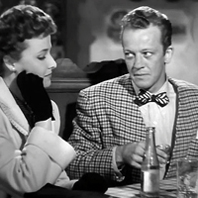Here are 10 things you should know about Robert Ryan, born 114 years ago today. He was one of the best “bad guys” in Hollywood history, though he occasionally expressed frustration with his limited range of roles.
Tag: Robert Ryan
10 Things You Should Know About Janis Carter
Here are 10 things you should know about Janis Carter, born 110 years ago today. She had dreams of being an opera singer, but the Broadway stage and then the movies and television won out.
10 Things You Should Know About Martha Scott
Here are 10 things you should know about Martha Scott, born 109 years ago today. In 50-year career, she enjoyed success in pictures, television and on Broadway.
The Set-Up Delivers a Knock-Out Punch
Sunday’s installment of Noir Alley on TCM (10am ET) is a don’t-miss (set those DVRs now). The Set-Up (1949) stars the great Robert Ryan as Bill ‘Stoker’ Thompson, an over-the-hill boxer who can’t bring himself to pull the plug on his dreams of pugilistic glory. His wife (Audrey Totter) begs him to stop fighting, but for Stoker, it’s always the next bout that will start his climb to the top.
The problem is, Stoker loses so often that his manager has taken money from a gangster on the assurance him that Stoker will take a dive in his next fight—but he hasn’t told Stoker.
The Set-Up holds the distinction of being perhaps the only film noir to be based on a poem, a narrative work written in 1928 by Joseph Moncure March. The poem and film share a title and a premise, but March’s boxer was a skilled African-American fighter nicknamed Pansy—“He’d carve you up like a leg of mutton,” wrote March—who had just been released from prison.
The picture takes place in real time, running a tidy, tense 73 minutes. Director Robert Wise gives the picture a gritty quality that suits the subject matter (and the genre) perfectly.
If you’ve never seen what many consider to be the best boxing picture ever (and certainly the best released before 1950), here’s your chance. Don’t blow it.

Life Without Lapels
We love us some vintage clothing; easily 80% of the clothes we wear on a daily basis are older than we are (we made our debut in 1958, in case you’re wondering).
So whenever we watch old movies (which, as longtime readers know, we do often), we spend as much time and energy focusing on the garments the actors are sporting as on the plot, performances and photography.
We especially like it when we encounter a garment, an accessory, a look unlike any we’ve seen before, and we came across an example of just that recently when we watched the Cold War noir, The Woman On Pier 13 (1949), starring Robert Ryan, Laraine Day, and John Agar.
William Talman, perhaps best remembered as Hamilton Burger, the DA Raymond Burr mopped the floor with week after week on “Perry Mason,” also appears in a supporting role as a bad guy (it was his motion picture debut). And in one scene that finds him squiring Day around from one seedy nightspot to the next, he wears a plaid jacket like none we’d ever seen.
And while we can’t honestly say we liked the look, it was at least interesting.
We are familiar, as perhaps you are, too, with several varieties of lapels on men’s sports, suit and formal jackets—notch, peak, shawl—but outside of the Nehru jackets that enjoyed their brief moment in the sun in the 1960s, we’d never before seen a man, on the silver screen or on the street, sporting a plaid sportscoat that had no lapels at all.
We turned to Marc Chevalier, easily the most knowledgeable person we’re acquainted with when it comes to vintage menswear. Here’s what he had to offer:
“Jackets like this one were briefly popular in the early to mid-1940s. The style originated in California, and was probably first designed by Clinton Stoner. Frank Sinatra was the most famous wearer of this type of jacket, back in the early ’40s.
“I seem to recall that it was called a “cardigan sportcoat” or some such thing.”
There you have it. A Google search yielded no mention of the term “cardigan jacket,” but Marc’s word is certainly good enough for us. However, we also couldn’t find any info about Clinton Stoner, and our curiosity got the better of us. Thankfully, Marc, bless his heart, had the full scoop (we knew he would):
“Clinton Stoner was a freelance men’s suit and sportswear designer whose merchant clients included Macintosh Studio Clothes and Saks Fifth Avenue. In the late 1940s, he opened his own custom sportswear shop—named “Clinton Stoner”—on the east end of the Sunset Strip. Stoner’s shop was a favorite of gangster Mickey Cohen, actor Robert Mitchum, etc. Stoner’s daughter, Beverly, achieved some notoriety of her own as a much-married, much abused nightclub singer.”
You won’t see us adopting Stoner’s (and Sinatra’s) lapel-free style anytime soon, but we are intrigued by the look.



